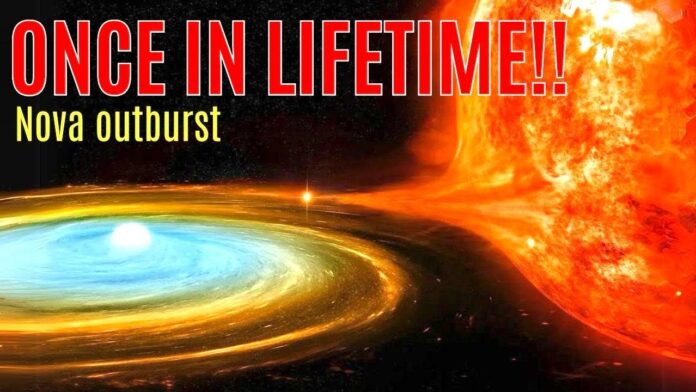A thermonuclear explosion on a distant dwarf star, last seen in 1946, is set to dazzle the skies between now and September
In the vast expanse of the cosmos, a celestial event of unprecedented rarity is poised to captivate astronomers and stargazers alike. T Coronae Borealis, affectionately known as the Blaze star, is preparing to unleash a spectacular display of light and energy that has been travelling towards Earth for over 3,000 years. Dr. Laura Driessen, a physicist from the University of Sydney, describes this impending phenomenon as akin to witnessing Orion’s bright foot for observers in the southern hemisphere and as radiant as the north star for those in the northern hemisphere.
T Coronae Borealis is classified as a recurrent nova, a classification reserved for stars that undergo periodic outbursts following a buildup of hydrogen from a neighbouring red giant onto the surface of a white dwarf. This process triggers a thermonuclear explosion, known as a nova, recurring roughly every 80 years in the case of T CrB. Astronomers anticipate this stellar spectacle to become visible at any moment, remaining observable until September.
The star’s behaviour has been documented over centuries, with its first recorded sighting dating back to 1217 by the abbot of Ursberg in Germany, who noted its brief yet intense luminosity. The last observed eruption was in 1946, marking a significant period of anticipation for astronomers awaiting its return. Dr. Driessen explains that in the decade preceding such events, the star exhibits fluctuations in brightness, a telltale sign of the imminent buildup leading to an eventual nova.
This upcoming nova of T Coronae Borealis holds particular significance due to advancements in astronomical technology. For the first time, modern telescopes such as the James Webb Space Telescope and the Fermi Gamma-ray Space Telescope will provide unprecedented insights into the structure and dynamics of this stellar explosion. Dr. Elizabeth Hays, a scientist at Nasa’s Astroparticle Physics Laboratory, highlights the proximity of this event and the invaluable data it promises to yield across various wavelengths.
To aid enthusiasts and amateur astronomers in locating T Coronae Borealis, Nasa has developed detailed sky maps, while software like Stellarium offers interactive tools for tracking celestial movements. Dr. Driessen advises observers to seek out the darkest possible locations, far from city lights, and suggests using binoculars and red-tinted torches to preserve night vision during the spectacle.
Analysis:
Political Analysis: The astronomical event of T Coronae Borealis does not directly impact political scenarios. However, international cooperation in astronomical research, as evidenced by collaborations between institutions and researchers worldwide, highlights the peaceful and collaborative nature of scientific endeavours. Such collaborations often transcend geopolitical boundaries, fostering goodwill and mutual respect among nations engaged in scientific exploration.
Social Analysis: The impending nova of T Coronae Borealis is set to capture public imagination and inspire interest in astronomy globally. Events of this nature provide opportunities for science communication and public engagement, encouraging people of all ages and backgrounds to look up at the night sky and contemplate the universe’s wonders. Amateur astronomers, educators, and science communicators will play crucial roles in translating complex astronomical phenomena into accessible knowledge, potentially sparking curiosity among future scientists.
Racial Analysis: The celestial event of T Coronae Borealis does not have direct implications for racial issues. Astronomy and scientific exploration generally transcend racial boundaries, welcoming contributions from diverse communities globally. However, efforts to diversify the field of astronomy and STEM more broadly remain crucial to ensuring equitable participation and representation across all scientific disciplines.
Gender Analysis: The involvement of scientists like Dr. Laura Driessen from the University of Sydney underscores the importance of gender diversity in astronomy. Historically, women have made significant contributions to astronomy despite facing barriers to participation. Highlighting the contributions of women scientists in events like the T Coronae Borealis nova not only celebrates their achievements but also promotes gender equity in STEM fields. Encouraging more women and girls to pursue careers in astronomy and related sciences is vital for fostering innovation and diversity in scientific research.
Economic Analysis: Investments in astronomical research and the development of advanced telescopic technologies, such as the James Webb Space Telescope and the Fermi Gamma-ray Space Telescope, contribute to technological advancements that extend beyond astronomy. These investments stimulate economic growth through the creation of high-tech jobs, innovation in space technologies, and educational opportunities in STEM fields. Furthermore, public interest in astronomical events like the T Coronae Borealis nova event can drive tourism to dark-sky locations, benefiting local economies.
